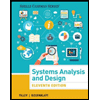
Explanation of Solution
The need for a process documentation standard:
In order to accomplish a business function a set of activities, repositories, roles and resources interact. This network is known as Business Process
One needs to process documentation standard because; two different software models have inconsistency and differences, which can be problematic; considering the fact especially when two different organizations with two different sets of definitions must work together. So in order to solve this problem a standard set of terms and graphical notations were created to document business processes.
Swim-Lane Layout:
In an as-is model most of the details are omitted. The process is represented in a swim-lane layout in which each role in the business process is given its own swim lane. It is useful as it simplifies the process diagram and draws attention to the interactions among components of the diagram.
The symbols in figures 12-7 and 12-8:
Fig 12.7 represents Process diagram for existing order process and figure 12.8 represents process diagram for customer credit check process.
In fig 12.7 and fig 12.8 there are five roles and hence five swim lanes are present and all activities roles are present in the swim lane.
There are two types of arrows displayed: Dotted arrows and solid arrows.
- Dotted arrows shows depict the flow of messages and data flows whereas solid arrows depict the flow of sequences of activities in the process.
- Diamonds are used to represent decisions and are basically used to represent questions which can be answered with yes or no, in which the arrows labelled yes or no exit the two ends of the diamond...
Want to see the full answer?
Check out a sample textbook solution
Chapter 12 Solutions
EBK USING MIS
- Answer two JAVA OOP problems.arrow_forward= 3. [40 pts] In the following C program ex2_2.c, we first declare and initialize an array int arr[3] {1,3,5}. Please convert the C code in main function into Assembly language. We provide the array initialization code in ex2_2_assembly.s for reference. Please complete and submit your code. ex2_2.c: #include int main() { } int arr[3] ={1,3,5}; //declare and initialize the array arr int x11 = arr[0]; int x12 = arr[1]; int x13 =x11x12; int x14 = x13 << x11; // "<<" is left shift operator arr[1] arr [2] = x13; = x14; return 0; //no need to convert this line into assembly languagearrow_forwardPlease answer JAVA OOP problem.arrow_forward
- Answer these two JAVA OOP questions.arrow_forwardPlease answer two JAVA OOP questions.arrow_forwardNow unmount the filesystem. Create a sparse image file, called book.img, of the 2GiB hard drive. Use a hexdump program to look at book.img and work out the offsets that store the contents of the book youdownloaded. Record the offsets as a sequence of one or more ranges of hexadecimal numbers. For example, in the following hexdump the text The rain in Spain falls mainly on the plain. is stored at 0x10-0x1f, 0x30-0x4b (inclusive). 00000000: 0000 0000 0000 0000 0000 0000 0000 0000 .................00000010: 5468 6520 7261 696e 2069 6e20 5370 6169 The rain in Spai00000020: 0000 0000 0000 0000 0000 0000 0000 0000.................00000030: 6e20 6661 6c6c 7320 6d61 696e 6c79 206f n falls mainly 000000040: 6e20 7468 6520 706c 6169 6e2e 0000 0000 n the plain........ Compress the filesystem using gzip by running: #gzip book.img This should leave you with a file book.img.gz. You will use scp to transfer this file in a later task. Enter your ranges in answers2.json as the answer for question1. To…arrow_forward
- Task 4: Examine floppy.img Mount floppy.img at a suitable mountpoint inside your VM. Look inside the mountpoint directory. You should see a number of files in the top-level directory. Look inside your answers2.json at the strings labelled contentA and contentB. Exactly one of those two strings appears as the content of a file in the floppy disk's filesystem. I.e., there is a file that contains contentA or a file that contains contentB but not both. Additionally, the other string has been written into unused space of the floppy disk, so the data is in floppy.img but cannot be seen inside any of the files at the mountpoint. However it can be seen in a hexdump of floppy.img. I.e., if there is a file that contains contentA then contentB has been written into unused space. You must search through your mountpoint directory to find out which of contentA and contentB is stored in a file of the filesystem and which is stored in unused space. Suppose that contentA is stored in a file, and…arrow_forwardDownload your personalized assignment files, answers2.json and floppy.img, into your Kali Linux Vm. Use wget as before. For example, you'd use "wgetarrow_forward▼ description: answer: question2: ▼ description: answer: "What are the offset ranges for the book file content within book.img?" "YOUR ANSWER GOES HERE" "What are the offset ranges for the content in unused space within floppy.img?" "YOUR ANSWER GOES HERE"arrow_forward
- Task 3: Creating a Sample Hard Drive Image book.img Add a new (virtual) hard drive of capacity 2GiB to your Kali Linux VM. Create a FAT filesystem on the hard drive using mkfs. fat. Be careful to use your new 2GiB drive! It would be a good idea to use 1sblk to verify the block device name before proceeding. Mount the new hard drive at a mount point of your choice. Find a book from Project Gutenberg by an author whose last name begins with the same letter as your last name (look under "Browsing Options" and then "Authors" A-Z). Download the plain text UTF-8 and ensure it is saved into your mounted drive (it should be saved within the mount point directory). For example, using The Royal Guide to Wax Flower Modelling by Emma Peachey (a cracking read, no doubt) we can download the plain text file using:arrow_forward- Is FD A a partial or transitive dependency?- Is FD B a partial or transitive dependency?- Is FD C a partial or transitive dependency?- In what normal form is the relation Parking Tables?- Convert the relation Parking Tables to a set of 3NF relations.arrow_forwardWhat happens to MAC addresses as frames travel from one node (device) to another? What happens to MAC addresses as frames travel from one network to another? What happens to IP addresses as packets travel from one node (device) to another? What happens to IP addresses as packets travel from one network to another?arrow_forward
 Systems Analysis and Design (Shelly Cashman Serie...Computer ScienceISBN:9781305494602Author:Scott Tilley, Harry J. RosenblattPublisher:Cengage Learning
Systems Analysis and Design (Shelly Cashman Serie...Computer ScienceISBN:9781305494602Author:Scott Tilley, Harry J. RosenblattPublisher:Cengage Learning Database Systems: Design, Implementation, & Manag...Computer ScienceISBN:9781305627482Author:Carlos Coronel, Steven MorrisPublisher:Cengage Learning
Database Systems: Design, Implementation, & Manag...Computer ScienceISBN:9781305627482Author:Carlos Coronel, Steven MorrisPublisher:Cengage Learning Database Systems: Design, Implementation, & Manag...Computer ScienceISBN:9781285196145Author:Steven, Steven Morris, Carlos Coronel, Carlos, Coronel, Carlos; Morris, Carlos Coronel and Steven Morris, Carlos Coronel; Steven Morris, Steven Morris; Carlos CoronelPublisher:Cengage Learning
Database Systems: Design, Implementation, & Manag...Computer ScienceISBN:9781285196145Author:Steven, Steven Morris, Carlos Coronel, Carlos, Coronel, Carlos; Morris, Carlos Coronel and Steven Morris, Carlos Coronel; Steven Morris, Steven Morris; Carlos CoronelPublisher:Cengage Learning COMPREHENSIVE MICROSOFT OFFICE 365 EXCEComputer ScienceISBN:9780357392676Author:FREUND, StevenPublisher:CENGAGE L
COMPREHENSIVE MICROSOFT OFFICE 365 EXCEComputer ScienceISBN:9780357392676Author:FREUND, StevenPublisher:CENGAGE L





